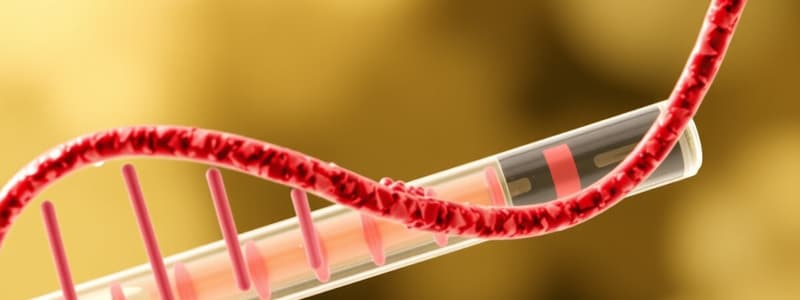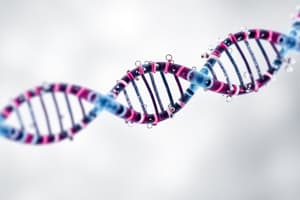Podcast
Questions and Answers
What is the purpose of primers in PCR?
What is the purpose of primers in PCR?
- To initiate the replication process (correct)
- To amplify the entire genome
- To denature the DNA strands
- To add nucleotides to the DNA
The denaturation step of PCR requires a temperature of approximately 72°C.
The denaturation step of PCR requires a temperature of approximately 72°C.
False (B)
Name one application of PCR technology.
Name one application of PCR technology.
Medical Diagnostics, Genetic Research, Forensic Science, or Gene Therapy
PCR is repeated for _____ cycles to amplify the target DNA sequence.
PCR is repeated for _____ cycles to amplify the target DNA sequence.
Which type of PCR is used to monitor the amplification process in real-time?
Which type of PCR is used to monitor the amplification process in real-time?
Match the types of PCR with their descriptions:
Match the types of PCR with their descriptions:
Contamination in PCR can lead to accurate results.
Contamination in PCR can lead to accurate results.
DNA Polymerase is an enzyme responsible for _____ new DNA strands during PCR.
DNA Polymerase is an enzyme responsible for _____ new DNA strands during PCR.
Flashcards are hidden until you start studying
Study Notes
Recombinant DNA Technology: PCR Techniques
-
Definition: Polymerase Chain Reaction (PCR) is a method used to amplify specific DNA sequences, generating millions of copies from a small initial sample.
-
Key Components:
- Template DNA: The DNA containing the target sequence to be amplified.
- Primers: Short, specific sequences of nucleotides that bind to the template DNA and initiate replication.
- DNA Polymerase: An enzyme that synthesizes new DNA strands by adding nucleotides to the primers.
- Nucleotides (dNTPs): Building blocks for DNA synthesis (adenine, thymine, cytosine, guanine).
-
PCR Process:
- Denaturation: Heating the reaction mixture to separate the DNA strands (typically at 94-98°C).
- Annealing: Cooling the mixture to allow primers to bind to the single-stranded DNA templates (usually at 50-65°C).
- Extension: Raising the temperature for DNA polymerase to synthesize new DNA strands by adding nucleotides to the primers (around 72°C).
-
Cycle Repetition: The denaturation, annealing, and extension steps are repeated for 20-40 cycles, exponentially amplifying the target DNA sequence.
-
Types of PCR:
- Standard PCR: Basic amplification of DNA.
- Real-Time PCR (qPCR): Monitors the amplification process in real-time, often using fluorescent dyes.
- Reverse Transcription PCR (RT-PCR): Converts RNA into DNA before amplification, useful for gene expression studies.
- Multiplex PCR: Amplifies multiple targets in a single reaction by using multiple sets of primers.
-
Applications:
- Genetic Research: Cloning, sequencing, and analyzing genes.
- Medical Diagnostics: Detecting pathogens and genetic disorders.
- Forensic Science: Analyzing DNA from crime scenes.
- Gene Therapy: Delivering therapeutic genes to treat diseases.
-
Advantages:
- High specificity for target sequences.
- Rapid amplification process.
- Minimal sample requirement.
-
Limitations:
- Contamination can lead to false results.
- Primer design is critical for specificity and efficiency.
- Requires knowledge of the target sequence for primer synthesis.
PCR Techniques Overview
- Polymerase Chain Reaction (PCR) amplifies specific DNA sequences, producing millions of copies from a minimal sample.
Key Components
- Template DNA: Contains the target sequence for amplification.
- Primers: Short sequences that bind to template DNA, essential for initiating the replication process.
- DNA Polymerase: Enzyme responsible for synthesizing new DNA strands.
- Nucleotides (dNTPs): Building blocks of DNA, consisting of adenine, thymine, cytosine, and guanine.
PCR Process Steps
- Denaturation: Heating DNA to 94-98°C to separate strands.
- Annealing: Cooling to 50-65°C allows primers to attach to single-stranded DNA templates.
- Extension: Temperature raised to approximately 72°C for DNA Polymerase to add nucleotides, completing the new DNA strands.
- The cycle of denaturation, annealing, and extension is repeated for 20-40 cycles, exponentially increasing the target DNA quantity.
Types of PCR Techniques
- Standard PCR: Basic method for DNA amplification.
- Real-Time PCR (qPCR): Monitors the amplification process dynamically, often using fluorescent dyes for observation.
- Reverse Transcription PCR (RT-PCR): Transcribes RNA into DNA for amplification, useful in gene expression analysis.
- Multiplex PCR: Simultaneously amplifies multiple targets using various primer sets in one reaction.
Applications of PCR
- Genetic Research: Facilitates cloning, sequencing, and gene analysis.
- Medical Diagnostics: Enables detection of pathogens and genetic disorders through amplified DNA.
- Forensic Science: Analyzes DNA samples from crime scenes for identification purposes.
- Gene Therapy: Aids in delivering therapeutic genes to mitigate diseases.
Advantages of PCR
- High specificity for targeted sequences ensures accurate results.
- Rapid amplification allows for quick analysis and results.
- Requires minimal sample material, making it efficient for various applications.
Limitations of PCR
- Contamination can result in misleading outcomes, necessitating careful handling.
- Specificity and efficiency heavily depend on the proper design of primers.
- A thorough understanding of the target sequence is essential for successful primer synthesis.
Studying That Suits You
Use AI to generate personalized quizzes and flashcards to suit your learning preferences.




